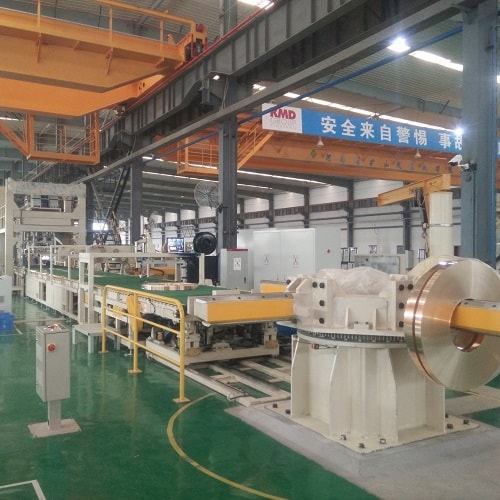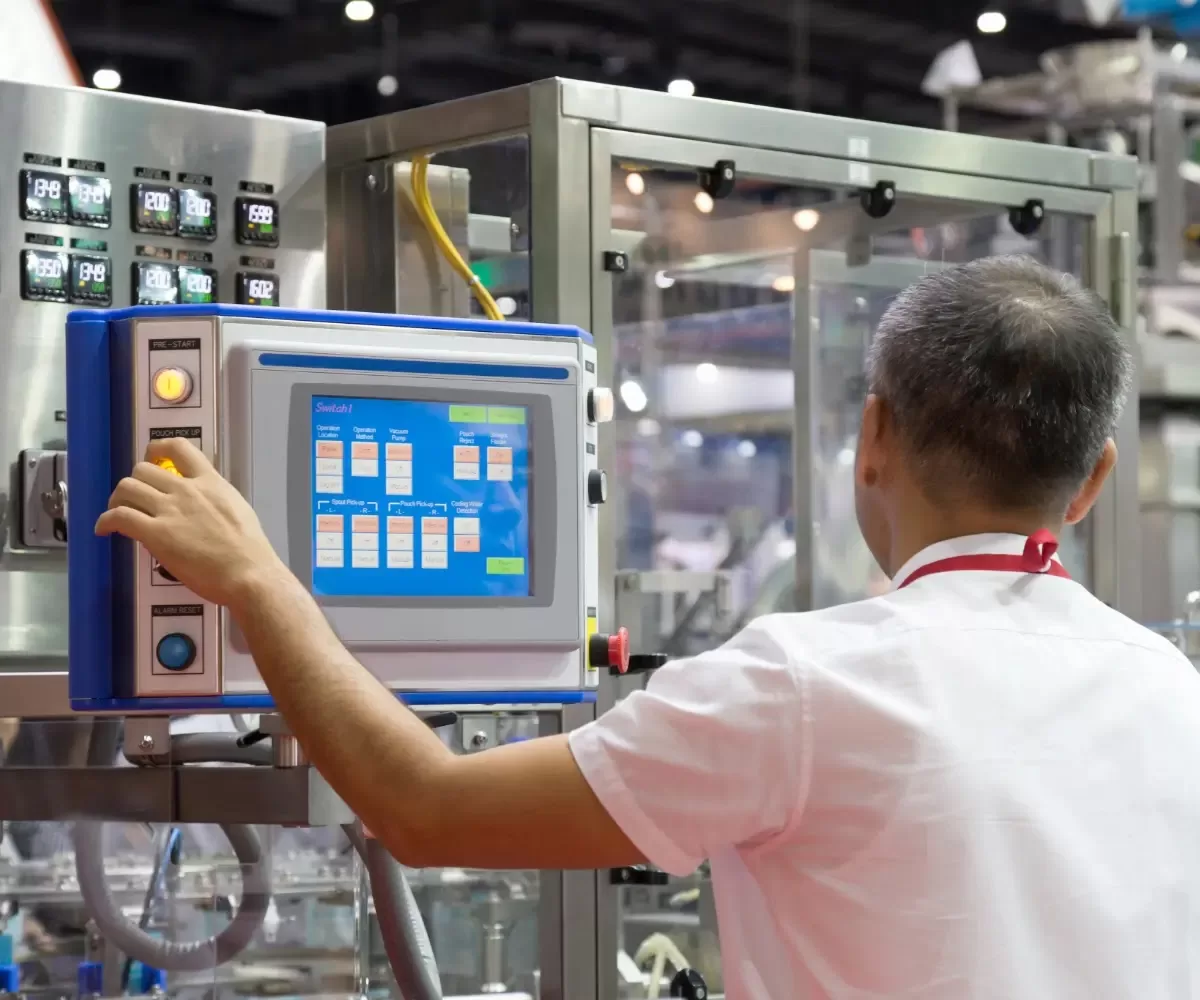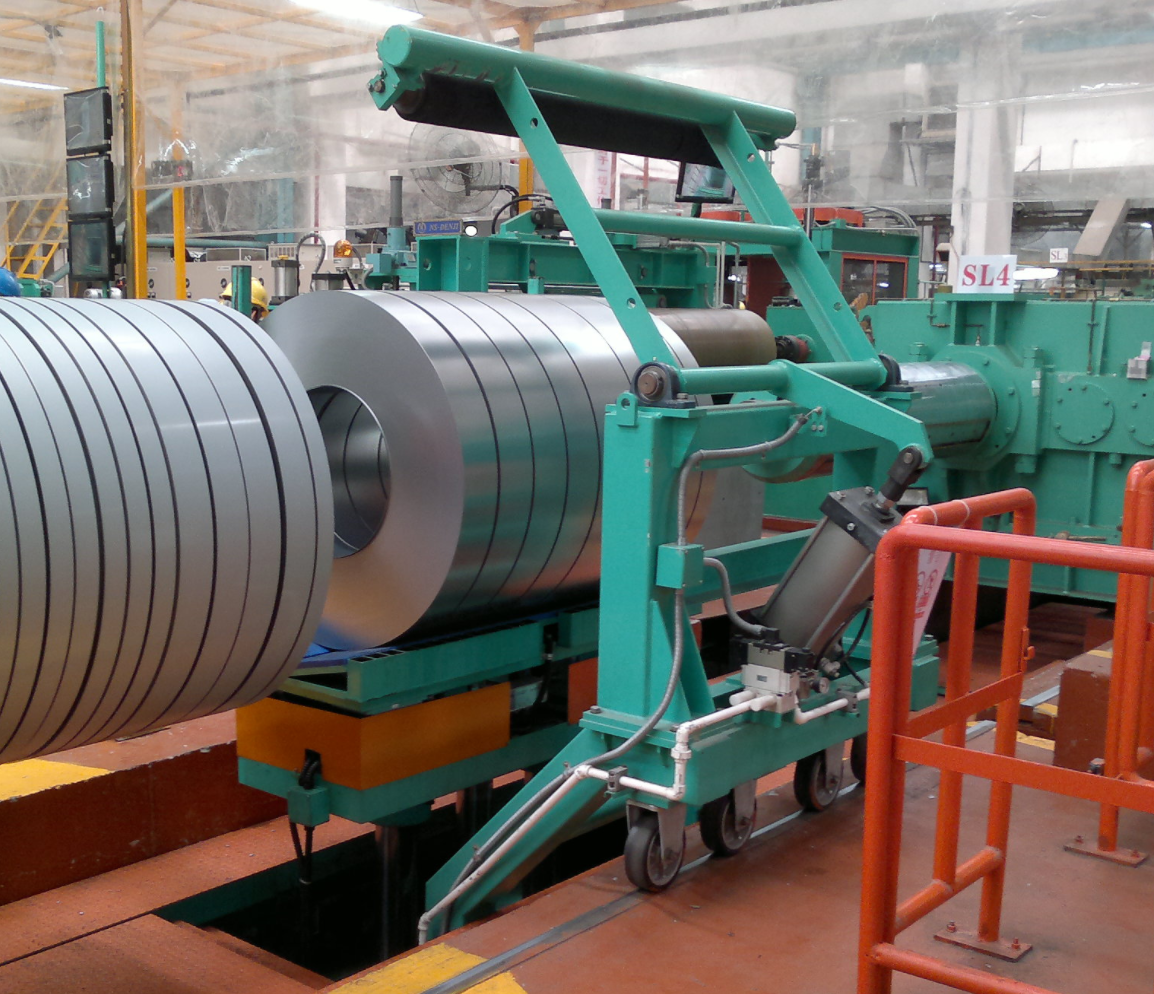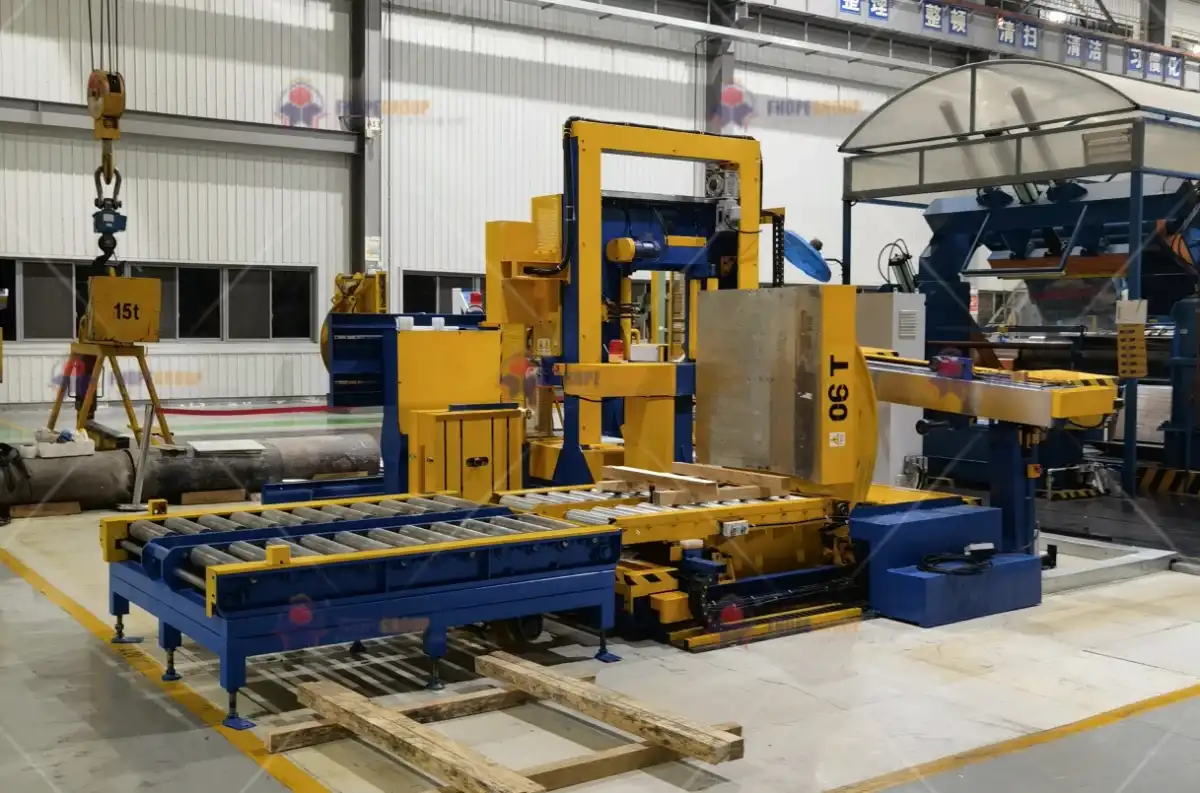Your slitting line runs perfectly. The steel coils are pristine, meeting every quality check. But then they reach the end of the line, and everything slows down. The packaging area is a bottleneck, a mix of manual labor, inconsistent wrapping, and constant delays. You worry that this final, crucial step is undermining all the hard work that came before it, exposing your high-quality products to damage during transit and leading to potential customer complaints. This inefficiency is a quiet drain on your profits. In the competitive U.S. market, every moment of downtime, every dollar in wasted material, and every minute of extra labor erodes your margin. I've walked factory floors and seen this exact problem countless times. The good news is that there is a solution. By focusing on a complete, integrated system for your end-of-line packaging, you can turn this weak point into a major strength.
Achieving end-of-line coil packaging efficiency in the U.S. market requires a holistic approach. It involves integrating automated wrapping machines, smart conveyance systems, and robust data tracking. This combination minimizes manual labor, reduces packaging material waste, and ensures consistent, high-quality protection for every coil, from your mill to your customer's door.

This is the big picture, but success is found in the details. To truly transform your packaging operations, we need to break down the process. It's about more than just buying a new machine. It's about building a system. We will look at the specific challenges you face, like rising labor costs and aging equipment. Then, we will explore the practical, real-world solutions that can solve them. Let's dive into how to choose the right equipment, integrate it seamlessly with your existing lines, and ensure it delivers the efficiency and reliability you need to compete and win.
How Can Automated Systems Tackle Rising Labor Costs and Inconsistency?
Finding and keeping good people for the packaging line is a constant struggle, isn't it? The work is physically demanding, and manual wrapping is often slow. Even with the best team, consistency is a challenge. One tired worker or a moment of distraction can result in a poorly wrapped coil, which can mean a rejected shipment and a dissatisfied customer. These labor issues create a ripple effect. They cause production bottlenecks that slow down your entire plant. They also create unpredictable costs from overtime pay, high employee turnover, and the constant need for training. And we can't forget the safety risks involved with manually handling heavy materials. I've seen these issues firsthand in many factories. But I've also seen the solution. Investing in automated wrapping and strapping systems directly solves these problems, creating a safer, more predictable, and highly efficient packaging process.
Automated systems, such as orbital stretch wrappers and automatic strapping machines, directly tackle rising labor costs by reducing the need for manual intervention. They ensure every coil is packaged to the exact same standard, eliminating human error and inconsistency. This leads to lower labor expenses, higher throughput, and improved product protection.

Dive Deeper: The True Value of Automation
When we talk about automation, we're not just talking about one machine. We're talking about a system designed to your specific needs. This could be a horizontal orbital wrapper that cocoons your steel coils in protective film, or an automatic strapping machine that applies steel or PET straps with precise tension and placement. The goal is to remove the variables of manual labor from the quality equation.
The Financial Impact: Direct and Indirect Savings
The most obvious benefit of automation is reducing direct labor costs. You need fewer people to do the same amount of work, which means savings on wages, benefits, and overtime. But the real financial power of automation comes from the indirect savings. Think about the costs associated with employee turnover. Recruitment and training are expensive. Automation stabilizes your workforce. It also dramatically improves safety. Manual packaging of heavy coils is a high-risk job. By automating it, you reduce the chance of workplace injuries, which can lead to lower insurance premiums and fewer lost workdays. And a well-calibrated machine uses the exact amount of packaging material needed, every single time. This consistency reduces material waste, a cost that adds up quickly over a year.
Consistency is King
In the U.S. market, your customers expect perfection. An automated system delivers it. You can program the machine with specific "recipes" for different products. For example, Coil Type A gets 5 layers of stretch film with 4 radial straps. Coil Type B gets 3 layers and 6 straps. The machine executes these instructions perfectly every time, 24/7. This guarantees that your product arrives at its destination in the same condition it left your mill. This level of quality control is something manual labor can never consistently match. It also means you can confidently promise your customers a certain standard of packaging, which strengthens your brand reputation.
| Metric | Manual Packaging | Automated Packaging |
|---|---|---|
| Speed | Slow, variable | Fast, consistent |
| Consistency | Low, operator-dependent | High, machine-controlled |
| Labor Cost | High, recurring | Low, upfront investment |
| Safety Risk | High | Very Low |
| Material Waste | High, variable | Low, optimized |
What's the Real ROI of Upgrading Your Coil Handling and Conveyance?
You just invested in a new high-speed slitting line. It's a fantastic piece of equipment. But now you have a new problem. Coils are coming off the line faster than your team can move them. They start to pile up on the floor, waiting for a forklift. This creates a massive bottleneck. It also introduces a serious safety hazard into your plant. The floor becomes an obstacle course of multi-ton steel coils. That high-speed line you paid for is now being held back by an outdated material handling process. Every minute a coil sits idle is a loss of potential revenue. You're not just losing time; you're creating risks and inefficiencies that eat into your profits. I remember a client in a similar situation. We fixed it not by changing the packaging machine, but by fixing the flow to the machine. An integrated coil handling and conveyance system is the solution that unlocks the true potential of your production line.
The real return on investment (ROI) from upgrading coil handling and conveyance goes beyond speed. It comes from increased overall equipment effectiveness (OEE), a dramatic reduction in safety incidents, less product damage from manual handling, and optimized use of valuable floor space. It transforms a disconnected process into a continuous, efficient flow.

Dive Deeper: Building a Bridge for Your Coils
A modern conveyance system is the bridge between your production and packaging areas. It eliminates the stop-and-go process of using forklifts. Instead, it creates a smooth, continuous, and automated flow. This system can be made of several key components working together. Turnstiles can receive coils from the slitter and queue them. Walking beam conveyors can move them forward in sequence. Coil cars, either running on rails on the floor or in a pit, can then transport the coils efficiently over longer distances to the entry point of the packaging line. The key is to create a small buffer of coils that are always ready for packaging. This ensures your wrapping machine is never waiting for product, and your slitting line is never waiting for coils to be cleared.
Calculating the True Return on Your Investment
To understand the real ROI, we have to look beyond the purchase price of the equipment. A proper analysis will show returns in several key areas.
- Increased Throughput: If your bottleneck is conveyance, fixing it means you can ship more tons of steel per day. This is a direct and powerful revenue increase.
- Reduced Product Damage: Forklifts, especially in a crowded space, can easily dent or damage the edges of a steel coil. A damaged coil often has to be scrapped or sold at a discount. Automated conveyance is gentle and precise, eliminating this common source of loss.
- Labor Optimization: A fully automated conveyance system means the forklift driver who was moving coils can now be reassigned to other valuable tasks, like loading trucks for shipment.
- Enhanced Safety: This is a huge factor. Removing forklift traffic and manual handling of coils drastically reduces the risk of accidents. In the U.S., this helps with OSHA compliance and can have a positive impact on your insurance costs.
A simplified ROI calculation might look something like this:
| Savings Area | Estimated Annual Savings |
|---|---|
| Increased Production (10 extra coils/day) | $150,000 |
| Reduced Coil Damage (2 fewer coils/month) | $24,000 |
| Labor Re-allocation (1 operator) | $60,000 |
| Total Annual Savings | $234,000 |
This simple model shows how an investment in conveyance can pay for itself very quickly.
How Does Data Integration in Packaging Lines Drive Profitability?
You have dashboards showing every detail of your production process, from the furnace to the slitter. But what about the packaging line? For many mills, this final stage is a "black box." You know coils go in and come out, but you don't know the specifics. You can't say for sure how long it took to wrap a specific coil, how much packaging film was used, or the exact reason the line stopped for ten minutes last Tuesday. This lack of visibility is a major roadblock to improvement. You can't fix problems you can't see. You are forced to guess about your true packaging costs, and you miss out on opportunities for optimization that your data-savvy competitors might be using to get ahead. This is a problem I'm passionate about solving. I started as an engineer, and I believe in the power of data. Modern packaging lines are not just mechanical systems; they are data-generating assets that can give you a powerful competitive edge.
Data integration drives profitability by providing real-time visibility into your packaging operations. It allows you to track key performance indicators (KPIs) like cycle time, material consumption, and downtime. This data enables predictive maintenance, optimizes resource use, and provides complete product traceability, which is highly valued in the U.S. market.

Dive Deeper: Turning Your Packaging Line into an Information Hub
Integrating your packaging line means connecting it to your plant's main information system, often called a Manufacturing Execution System (MES) or ERP. This connection allows for a two-way flow of information. The MES sends the coil ID to the packaging line, and the packaging line sends back a rich stream of data about the packaging process.
From Raw Data to Smart Decisions
The real power comes from turning this raw data into actionable insights.
- Predictive Maintenance: Instead of waiting for a motor to break, IoT sensors can track its temperature and vibration. When the data shows a trend that indicates a future failure, the system can automatically schedule maintenance during a planned shutdown. This single capability is a giant leap towards achieving 95% uptime.
- Cost Control: By tracking the exact amount of stretch film and strapping used for each coil, you can precisely calculate your packaging cost per ton. If you see that one shift is using 10% more film than another for the same product, you can investigate. Maybe a machine setting is wrong, or maybe the team needs more training. You can fix the problem because the data showed you where to look.
- Performance Optimization: Tracking cycle times and downtime reasons is critical. If the data shows the line stops for 30 seconds every 15 coils because of a specific fault, your maintenance team has a clear target. Fixing these small, recurring "micro-stops" can lead to a significant increase in overall throughput.
The Power of Traceability
For your customers in demanding sectors like automotive or aerospace, traceability is not a luxury; it's a requirement. With an integrated system, you can provide a complete "birth certificate" for each coil's packaging. You can tell your customer exactly when their coil was packaged, the machine settings used, the amount of material applied, and even the operator who was overseeing the line. This level of transparency and quality assurance is a powerful selling point. It shows that you are a professional, reliable supplier.
| Data Point Tracked | Business Outcome |
|---|---|
| Machine Fault Codes | Predictive Maintenance, Increased Uptime |
| Material Usage per Coil | Reduced Consumable Costs, Accurate Pricing |
| Cycle Time per Coil | Throughput Optimization, Bottleneck Analysis |
| Coil ID & Recipe Used | Full Traceability, Enhanced Quality Control |
Why is a Strategic Partner More Valuable Than Just a Machine Supplier?
You have probably bought a lot of equipment over the years. The experience is often the same. A salesperson makes big promises to get the sale. But after the machine is installed and the check is cleared, they become very hard to reach. When a problem comes up, getting support is a frustrating process. You and your team are left to figure things out on your own. A small issue that should be a quick fix turns into hours or even days of costly downtime. You bought a piece of metal, but you didn't get the full solution you were promised. This is precisely why I built my company, SHJLPACK, on a different philosophy. I believe in being a total solution provider. A true partner works with you from the very beginning, through installation and training, and provides reliable support for the entire life of the equipment. This is the fundamental difference between a simple transaction and a successful long-term relationship.
A strategic partner is more valuable because they provide a complete, long-term solution, not just a machine. They offer expertise in system design, integration with existing lines, customized solutions, operator training, and reliable after-sales support. This partnership ensures you maximize your investment and achieve your long-term operational goals.

Dive Deeper: The Partnership Lifecycle
A partnership is a journey that starts long before a purchase order is signed and continues long after the machine is running. It's a commitment to your success.
The Design Phase: Co-Creating Your Solution
A simple supplier will try to sell you a standard machine from their catalog. A strategic partner starts by listening. They visit your mill in the U.S. They walk the floor with you. They study your production flow, your coil specifications, and your space constraints. Most importantly, they ask about your goals. Are you trying to reduce costs by 8%? Increase uptime to 95%? They take this information and design a solution with you. When I was starting out as an engineer, I learned that this initial phase is the most critical. A solution that is custom-tailored to the client's reality is the only one that truly works.
Beyond Installation: Empowering Your Team
The job isn't done when the machine is bolted to the floor. A supplier might leave after a basic test run. A partner stays. We provide in-depth training for both your machine operators and your maintenance crew. We want them to be confident and capable. We help you program the initial wrapping recipes and fine-tune the settings to get the perfect balance of protection and material efficiency. And we don't disappear. We will check in with you after a few months to review the performance data and help you find new ways to optimize the process. We are invested in your team's success.
Long-Term Support: A Partner for the Future
Your business will change. You might start producing a new type of coil. Environmental regulations might get stricter. Market demands might shift. A partner is there to help you adapt. They can help you modify your equipment, suggest upgrades for better energy efficiency, and provide advice on integrating new digital tools. When you need a spare part, they have it available for quick shipment within the U.S. or can get it to you fast. This long-term commitment is the core of my philosophy. My own success came from the opportunities this industry gave me, and my goal now is to help my clients succeed in the same way.
| Aspect | Machine Supplier | Strategic Partner |
|---|---|---|
| Pre-Sale | Sells a standard product | Listens and co-designs a custom solution |
| Installation | Basic setup and test | Full integration and optimization |
| Training | Minimal, basic functions | In-depth for operators and maintenance |
| Post-Sale Support | Hard to reach, slow response | Proactive, responsive, ongoing optimization |
| Future Growth | Sells you a new machine | Helps you adapt and upgrade existing assets |
Conclusion
Optimizing your end-of-line packaging is achievable. By combining automation, smart conveyance, and a true strategic partner, you can boost efficiency and secure your mill’s profitability for the future.





